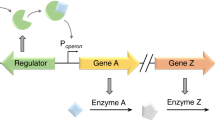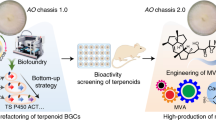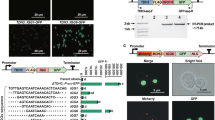Abstract
We describe a method to decipher the complex inter-relationships between metabolite production trends and gene expression events, and show how information gleaned from such studies can be applied to yield improved production strains. Genomic fragment microarrays were constructed for the Aspergillus terreus genome, and transcriptional profiles were generated from strains engineered to produce varying amounts of the medically significant natural product lovastatin. Metabolite detection methods were employed to quantify the polyketide-derived secondary metabolites lovastatin and (+)-geodin in broths from fermentations of the same strains. Association analysis of the resulting transcriptional and metabolic data sets provides mechanistic insight into the genetic and physiological control of lovastatin and (+)-geodin biosynthesis, and identifies novel components involved in the production of (+)-geodin, as well as other secondary metabolites. Furthermore, this analysis identifies specific tools, including promoters for reporter-based selection systems, that we employed to improve lovastatin production by A. terreus.
This is a preview of subscription content, access via your institution
Access options
Subscribe to this journal
Receive 12 print issues and online access
$209.00 per year
only $17.42 per issue
Buy this article
- Purchase on Springer Link
- Instant access to full article PDF
Prices may be subject to local taxes which are calculated during checkout


Similar content being viewed by others
References
Masurekar, P.S. Therapeutic metabolites. Biotechnology 21, 241–301 (1992).
Parekh, S., Vinci, V.A. & Strobel, R.J. Improvement of microbial strains and fermentation processes. Appl. Microbiol. Biotechnol. 54, 287–301 (2000).
Nielsen, J. The role of metabolic engineering in the production of secondary metabolites. Curr. Opin. Microbiol. 1, 330–336 (1998).
Nielsen, J. Metabolic engineering. Appl. Microbiol. Biotechnol. 55, 263–283 (2001).
Endo, A. Monacolin K. A new hypocholesterolemic agent produced by a Monascus species. J. Antibiot. 32, 852–854 (1979).
Endo, A., Kuroda, M. & Tsujita, Y. ML-236A, ML-236B, and ML-236C, new inhibitors of cholesterogenesis produced by Penicillium citrinium. J. Antibiot. 29, 1346–1348 (1976).
Endo, A., Kuroda, M. & Tanazawa, K. Competitive inhibition of 3-hydroxy-3-methylglutaryl coenzyme A reductase by ML236A and ML-236B fungal metabolites having hypocholesterolemic activity. FEBS Lett. 72, 323–326 (1976).
Tanazawa, K. & Endo, A. Kinetic analysis of the reaction catalyzed by rat-liver 3-hydroxy-3-methylglutaryl-coenzyme-A reductase using two specific inhibitors. Eur. J. Biochem. 98, 195–201 (1979).
Alberts, A.W. Discovery, biochemistry and biology of lovastatin. Am. J. Cardiol. 62, 10J–15J (1988).
Endo, A. Hypocholesterolemic agents. Biotechnology 26, 301–320 (1994).
Fujimoto, H., Flash, H. & Franck, B. Biosynthese der seco-anthrachinone geodin und dihydrogeodin aus emodin. Chem. Ber. 108, 1224–1228 (1975).
Sankawa, U., Ebizuka, Y. & Shibata, S. Biosynthetic incorporation of emodin and emodinanthrone into the anthraquinoids of Penicillium brunneum and P. islandicum. Tetrahedron Lett. 2125–2128 (1973).
Franck, B., Huper, F.,D.,G. & Erge, D. Seco-Anthrachinone nach einem neugefundenen Biosyntheseprinzip. Angew. Chem. 78, 752–753 (1976).
Birch, A.J., Baldas, J., Hlubucek, F.B., Simpson, T.J. & Westerman, P.W. Biosynthesis of the fungal xanthone ravenelin. J. Chem. Soc. Perkin Trans. I 898–904 (1976).
Kennedy, J. et al. Modulation of polyketide synthase activity by accessory proteins during lovastatin biosynthesis. Science 284, 1368–1372 (1999).
Hutchinson, C.R. et al. Aspects of the biosynthesis of non-aromatic fungal polyketides by iterative polyketide synthases. Antonie Van Leeuwenhoek 78, 287–295 (2000).
Bailey, C. & Arst, H.N., Jr. Carbon catabolite repression in Aspergillus nidulans. Eur. J. Biochem. 51, 573–577 (1975).
Dowzer, C.E. & Kelly, J.M. Cloning of the creA gene from Aspergillus nidulans: a gene involved in carbon catabolite repression. Curr. Genet. 15, 457–459 (1989).
Hicks, J.K., Yu, J.H., Keller, N.P. & Adams, T.H. Aspergillus sporulation and mycotoxin production both require inactivation of the FadA G alpha protein-dependent signaling pathway. EMBO J. 16, 4916–4923 (1997).
Tag, A. et al. G-protein signaling mediates differential production of toxic secondary metabolites. Mol. Microbiol. 38, 658–665 (2000).
Agresti, A. Categorical Data Analysis. (John Wiley & Sons, New York; 1990).
Goodman, L.A. & Kruskal, W.H. Measures of association for cross classifications. J. Am. Stat. Assoc. 49, 732–764 (1954).
Curtis, R.F., Hassall, C.H. & Parry, D.R. The biosynthesis of phenols. XXIV. The conversion of the anthraquinone question into the benzophenone, sulochrin, in cultures of Aspergillus terreus. J. Chem. Soc. Perkin Trans. I 2, 240–244 (1972).
Fujii, I., Iijima, H., Tsukita, S., Ebizuka, Y. & Sankawa, U. Purification and properties of dihydrogeodin oxidase from Aspergillus terreus. J. Biochem. (Tokyo) 101, 11–18 (1987).
Gatenbeck, S. & Malmstrom, L. On the biosynthesis of sulochrin. Acta. Chem. Scand. 23, 3493–3497 (1969).
Mayorga, M.E. & Timberlake, W.E. The developmentally regulated Aspergillus nidulans wA gene encodes a polypeptide homologous to polyketide and fatty acid synthases. Mol. Gen. Genet. 235, 205–212 (1992).
Takano, Y. et al. Structural analysis of PKS1, a polyketide synthase gene involved in melanin biosynthesis in Colletotrichum lagenarium. Mol. Gen. Genet. 249, 162–167 (1995).
Tsai, H.F., Wheeler, M.H., Chang, Y.C. & Kwon-Chung, K.J. A developmentally regulated gene cluster involved in conidial pigment biosynthesis in Aspergillus fumigatus. J. Bacteriol. 181, 6469–6477 (1999).
Fulton, T.R., Ibrahim, N., Losada, M.C., Grzegorski, D. & Tkacz, J.S. A melanin polyketide synthase (PKS) gene from Nodulisporium sp. that shows homology to the pks1 gene of Colletotrichum lagenarium. Mol. Gen. Genet. 262, 714–720 (1999).
Bingle, L.E.H., Simpson, T.J. & Lazarus, C.M. Ketosynthase domain probes identify two subclasses of fungal polyketide synthase genes. Fungal Genet. Biol. 26, 209–223 (1999).
Nicholson, T.P. et al. Design and utility of oligonucleotide gene probes for fungal polyketide synthases. Chem. Biol. 8, 157–178 (2001).
Fujii, I. et al. Cloning of the polyketide synthase gene atX from Aspergillus terreus and its identification as the 6-methylsalicylic acid synthase gene by heterologous expression. Mol. Gen. Genet. 253, 1–10 (1996).
Pazoutova, S., Linka, M., Storkova, S. & Schwab, H. Polyketide synthase gene pksM from Aspergillus terreus expressed during growth phase. Folia Microbiol. 42, 419–430 (1997).
Christensen, B.E. & Kaasgaard, S. Methods for producing polypeptides in Aspergillus mutant cells. World Patent Application WO 00/39322 (2000).
Drocourt, D., Calmels, T., Reynes, J.P., Baron, M. & Tiraby, G. Cassettes of the Streptoalloteichus hindustanus ble gene for transformation of lower and higher eukaryotes to phleomycin resistance. Nucleic Acids Res. 18, 4009 (1990).
Good, P. Permutation tests: A practical guide to resampling methods for testing hypotheses (Springer-Verlag, New York, 2000).
Ideker, T. et al. Integrated genomic and proteomic analyses of a systematically perturbed metabolic network. Science 292, 929–934 (2001).
Royer, J.C. et al. Fusarium graminearum A 3/5 as a novel host for heterologous protein production. Biotechnology 13, 1479–1483 (1995).
Szakacs, G., Morovjan, G. & Tengerdy, R.P. Production of lovastatin by a wild strain of Aspergillus terreus. Biotechnol. Lett. 20, 411–415 (1998).
Buckingham, J. Dictionary of Natural Products on CD-ROM, vol. 10:1 (Chapman & Hall / CRC Press, Boca Raton FL, 2001).
Altschul, S.F., Gish, W., Miller, W., Myers, E.W. & Lipman, D.J. Basic local alignment search tool. J. Mol. Biol. 215, 403–410 (1990).
Timberlake, W.E. Isolation of stage- and cell-specific genes from fungi. in Biology and Molecular Biology of Plant-Pathogen Interactions NATO ASI series H1 (ed. Bailey, J.) 343–357 (Springer-Verlag, Berlin Heidelberg, 1986).
Kelly, J.M. & Hynes, M.J. Transformation of Aspergillus niger by the amdS gene of Aspergillus nidulans. EMBO J. 4, 475–479 (1985).
Acknowledgements
We are grateful to Brian Cali, Gerry Fink, and Todd Milne for critical comments on this manuscript. In addition, the authors would like to thank all members of the Precision Engineering program at Microbia, Inc. for their support and helpful discussions.
Author information
Authors and Affiliations
Corresponding author
Ethics declarations
Competing interests
This work was supported by Microbia, Inc. All authors are or have been employed by Microbia, Inc., and the authors have had the option to become shareholders in the company. The authors declare that a patent application has been filed that relates to the content of this manuscript.
Supplementary information
Rights and permissions
About this article
Cite this article
Askenazi, M., Driggers, E., Holtzman, D. et al. Integrating transcriptional and metabolite profiles to direct the engineering of lovastatin-producing fungal strains. Nat Biotechnol 21, 150–156 (2003). https://doi.org/10.1038/nbt781
Received:
Accepted:
Published:
Issue Date:
DOI: https://doi.org/10.1038/nbt781
This article is cited by
-
A visualization reporter system for characterizing antibiotic biosynthetic gene clusters expression with high-sensitivity
Communications Biology (2022)
-
Co-cultivation of filamentous microorganisms in the presence of aluminum oxide microparticles
Applied Microbiology and Biotechnology (2022)
-
Fruitful decade of fungal metabolites as anti-diabetic agents from 2010 to 2019: emphasis on α-glucosidase inhibitors
Phytochemistry Reviews (2021)
-
Semi-rational mutagenesis of an industrial Streptomyces fungicidicus strain for improved enduracidin productivity
Applied Microbiology and Biotechnology (2020)
-
New knowledge about the biosynthesis of lovastatin and its production by fermentation of Aspergillus terreus
Applied Microbiology and Biotechnology (2020)



